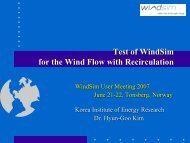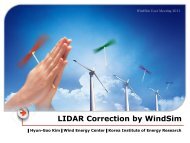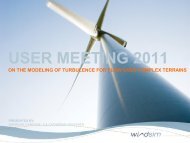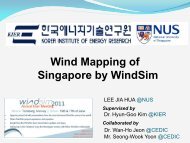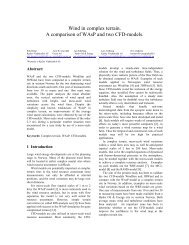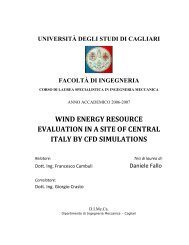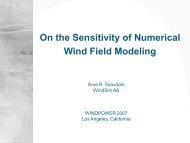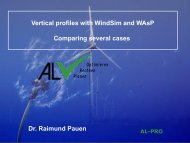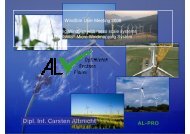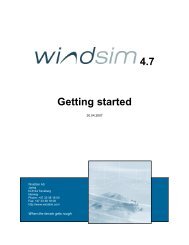Wind field simulations at Askervein hill - WindSim
Wind field simulations at Askervein hill - WindSim
Wind field simulations at Askervein hill - WindSim
Create successful ePaper yourself
Turn your PDF publications into a flip-book with our unique Google optimized e-Paper software.
ν T<br />
= l m<br />
U<br />
PHOENICS provides mixing-length expressions for use in simple geometries with zero- and<br />
one-equ<strong>at</strong>ion turbulence models which apply in the fully turbulent part of the flow, excluding<br />
the sublayer and buffer layer close to the wall. These expressions can be modified to make<br />
them applicable over the entire boundary layer, by using extensions which allow the<br />
influence of viscous effects very close to the wall. One such extension is th<strong>at</strong> proposed by<br />
Van Driest [1956], which takes the form:<br />
l<br />
m<br />
= l<br />
m0<br />
⎛ ⎛<br />
⎜1<br />
− exp⎜<br />
⎝ ⎝<br />
y<br />
A<br />
+<br />
+<br />
⎞⎞<br />
⎟⎟<br />
⎠⎠<br />
Uτ<br />
y<br />
g<br />
where l m0 is the unmodified mixing length, y + = and A+= 26.0. Here, y g is the normal<br />
ν<br />
τ<br />
w<br />
distance from the wall to the grid node, U τ is the friction velocity <strong>at</strong> the wall U<br />
τ<br />
= and ν<br />
ρ<br />
is the laminar kinem<strong>at</strong>ic viscosity.<br />
In general the damping constant A+ is not constant, and proposals may be found in the<br />
liter<strong>at</strong>ure which employ a functional rel<strong>at</strong>ionship for A+ so as to account for strong pressure<br />
gradients, mass transfer, compressibility, etc.<br />
2.2.2. k-ε model<br />
The k-ε model can also be used to close the set of equ<strong>at</strong>ions. It uses the dissip<strong>at</strong>ion r<strong>at</strong>e of<br />
turbulent kinetic energy ε.<br />
It is obvious th<strong>at</strong> the k-ε model can not predict all the details of the flow with accuracy.<br />
Nevertheless, experience proves th<strong>at</strong> this choice provides r<strong>at</strong>her good results, even in complex<br />
cases such as separ<strong>at</strong>ion (T.UTNES and K.J. EIDSVIK, 1996). This model is widely used in<br />
engineering applic<strong>at</strong>ions and proves to be well documented.<br />
The k-ε model provides the following equ<strong>at</strong>ions for k and ε :<br />
νT c k 2<br />
=<br />
µ<br />
ε<br />
( U k i )<br />
∂<br />
∂ ⎛ ν<br />
T ∂ k ⎞<br />
=<br />
ε<br />
∂ x ∂ x ⎜ σ ∂ x ⎟ + P −<br />
i<br />
i ⎝ k i ⎠ k<br />
∂<br />
∂ ⎛ ν ∂ ε ⎞ ε<br />
∂<br />
( U ε<br />
T<br />
x i ) = ⎜ ⎟ c<br />
∂ x ⎜ σ ∂ x ⎟ + ε k P c<br />
k<br />
− ε<br />
i i ⎝ ε i ⎠<br />
1 2<br />
ε<br />
2<br />
k<br />
This closure introduces several constants which are given two different sets of values.<br />
The standard values have been tuned to fit some basic flow problems such as, shear layer in<br />
local equilibrium, decaying grid turbulence and a boundary layer where logarithmic velocity<br />
profile prevails. The model constants can be adjusted in order to mimic other flow regimes.<br />
- 9 -




